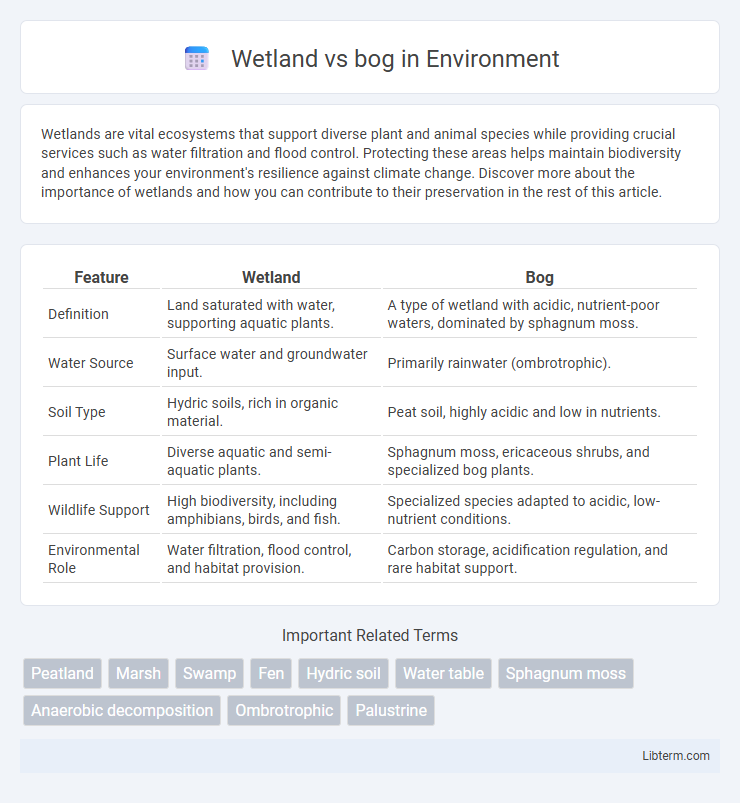Wetlands are vital ecosystems that support diverse plant and animal species while providing crucial services such as water filtration and flood control. Protecting these areas helps maintain biodiversity and enhances your environment's resilience against climate change. Discover more about the importance of wetlands and how you can contribute to their preservation in the rest of this article.
Table of Comparison
| Feature | Wetland | Bog |
|---|---|---|
| Definition | Land saturated with water, supporting aquatic plants. | A type of wetland with acidic, nutrient-poor waters, dominated by sphagnum moss. |
| Water Source | Surface water and groundwater input. | Primarily rainwater (ombrotrophic). |
| Soil Type | Hydric soils, rich in organic material. | Peat soil, highly acidic and low in nutrients. |
| Plant Life | Diverse aquatic and semi-aquatic plants. | Sphagnum moss, ericaceous shrubs, and specialized bog plants. |
| Wildlife Support | High biodiversity, including amphibians, birds, and fish. | Specialized species adapted to acidic, low-nutrient conditions. |
| Environmental Role | Water filtration, flood control, and habitat provision. | Carbon storage, acidification regulation, and rare habitat support. |
Introduction to Wetlands and Bogs
Wetlands are diverse ecosystems characterized by saturated soils and water-loving vegetation, playing critical roles in water filtration, flood control, and biodiversity support. Bogs, a specific type of wetland, are acidic, nutrient-poor environments dominated by sphagnum moss and peat accumulation, creating unique habitats for specialized plants and animals. Understanding the hydrology, soil composition, and vegetation of wetlands and bogs is essential for effective conservation and management strategies.
Defining Wetlands: Key Characteristics
Wetlands are ecosystems characterized by saturated soils, standing water, and diverse plant species adapted to hydric conditions. Bogs represent a specific type of wetland distinguished by accumulations of peat, acidic water, and nutrient-poor environments supporting sphagnum moss and specialized flora. These key characteristics determine the ecological functions and biodiversity unique to each wetland subtype.
What is a Bog? Unique Features Explained
A bog is a type of wetland characterized by acidic, nutrient-poor waters and a surface dominated by sphagnum moss which creates a thick, waterlogged peat layer. Unlike other wetlands, bogs receive water primarily from precipitation rather than runoff or groundwater, making them distinct in hydrology and ecology. The unique features of bogs include their ability to preserve plant material due to low oxygen levels and their specialized flora and fauna adapted to harsh, acidic environments.
Types of Wetlands: Where Do Bogs Fit?
Wetlands encompass diverse ecosystems including marshes, swamps, and bogs, each defined by unique hydrology, vegetation, and soil characteristics. Bogs are a specific type of wetland characterized by acidic, nutrient-poor conditions, primarily fed by precipitation rather than groundwater, leading to peat accumulation. Unlike marshes and swamps dominated by mineral-rich waters, bogs support specialized plant species like sphagnum moss and have significant carbon storage roles within global wetland types.
Formation Processes: Wetlands vs Bogs
Wetlands form through the accumulation of water in low-lying areas, promoting the growth of diverse vegetation and supporting rich biodiversity by maintaining saturated soils. Bogs specifically develop in cold, temperate regions where sphagnum moss accumulates, creating highly acidic and nutrient-poor conditions due to slow decomposition and waterlogged peat formation. Both ecosystems rely on water saturation, but bog formation is characterized by peat buildup and acidification, distinguishing it from other types of wetlands.
Biodiversity in Wetlands and Bogs
Wetlands support a diverse range of plant and animal species due to their nutrient-rich waters and varied habitats like marshes, swamps, and estuaries, fostering high biodiversity. Bogs, a type of wetland characterized by acidic, nutrient-poor conditions and sphagnum moss dominance, host specialized species adapted to harsh environments, resulting in unique but lower overall biodiversity. The ecological importance of wetlands lies in their ability to sustain complex food webs, while bogs play a critical role in carbon storage and supporting rare, endemic organisms.
Ecological Functions and Importance
Wetlands and bogs both serve crucial ecological functions by providing habitat for diverse species, regulating water cycles, and filtering pollutants to improve water quality. Bogs, a type of wetland characterized by acidic, nutrient-poor conditions and peat accumulation, play a significant role in carbon sequestration, helping to mitigate climate change by storing large amounts of carbon dioxide. Wetlands broadly support flood control, groundwater recharge, and serve as critical stopover sites for migratory birds, underscoring their importance in maintaining biodiversity and ecosystem health.
Geographic Distribution and Locations
Wetlands are distributed globally, found in every continent except Antarctica, commonly located in river valleys, coastal areas, and floodplains, supporting diverse ecosystems. Bogs mainly occur in cooler climates of the Northern Hemisphere, such as Canada, Northern Europe, and Russia, thriving in regions with poor drainage and acidic waters. Geographic locations of bogs are characterized by peat accumulation and a dominance of sphagnum moss, distinguishing them from broader wetland types.
Human Impact and Conservation Efforts
Wetlands, including bogs, face significant human impacts such as drainage for agriculture, urban development, and pollution, leading to habitat loss and decreased biodiversity. Conservation efforts prioritize protecting water quality, restoring natural hydrology, and implementing sustainable land-use practices to preserve these critical ecosystems. Targeted initiatives like wetland restoration projects and legal protections under frameworks such as the Ramsar Convention help mitigate human-induced degradation and support the ecological functions of both wetlands and bogs.
Wetland vs Bog: Key Differences Summarized
Wetlands are diverse ecosystems characterized by saturated soils and standing water, supporting a wide variety of plant and animal species, while bogs are a specific type of wetland distinguished by acidic, nutrient-poor conditions and accumulation of peat moss. Wetlands include marshes, swamps, and fens, with variable water chemistry and vegetation, whereas bogs are dominated by sphagnum moss and have low oxygen levels that slow decomposition. Understanding these differences is crucial for effective wetland conservation and management strategies.
Wetland Infographic

 libterm.com
libterm.com